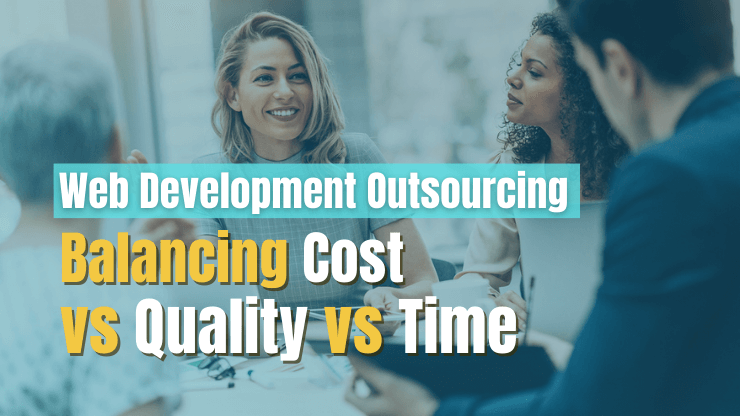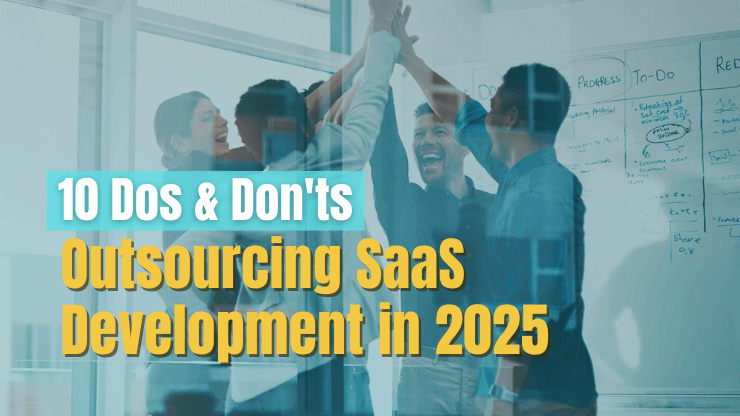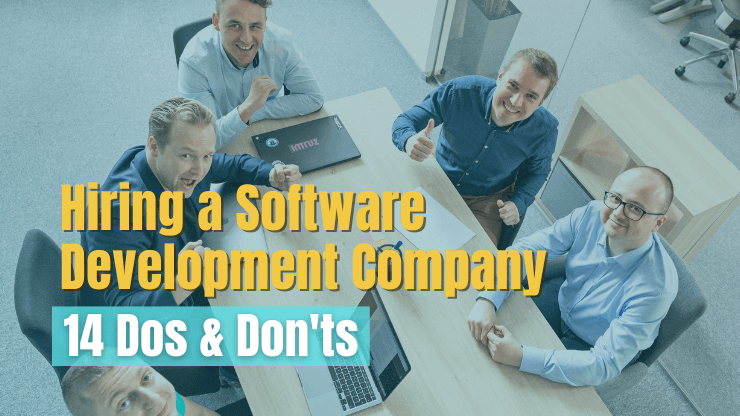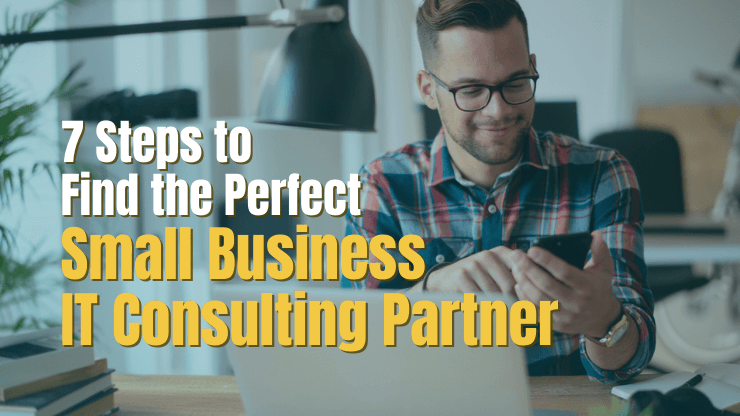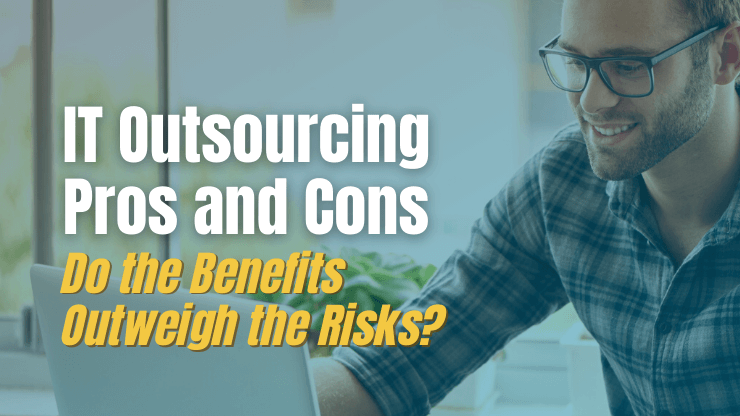The software-as-a-service market sits at over $146B globally, up over 5x in just 10 years. As the market has grown, so has competition in the space. It's not an easy feat to stand out amongst the hundreds of new SaaS companies that launch every year. Customers' expectations are high and patience is at an all time low.
To be successful, you need more than an innovative idea or funding. You need the tools to plan and execute your vision effectively. In this article we will share 8 essential steps for how to start a SaaS company. By the end, you'll have a clear roadmap for taking your business from concept to launch.
What is a software as a service (SaaS) company?
A SaaS company is a type of technology company that provides software as a service to its customers. SaaS companies typically host their software on the cloud and customers access it via the internet. Many offer their product with a subscription-based pricing model, where customers pay a monthly or annual fee to use the software.
SaaS companies have become increasingly popular in recent years as more and more businesses move to the cloud. SaaS provides many advantages for businesses, including the ability to scale quickly and reduce upfront costs.
There are a number of different types of SaaS companies, but the most common are CRM, HR, and accounting software. SaaS companies have the potential to disrupt traditional software companies, as they are able to provide a more flexible and affordable solution to businesses who are seeking software services.
How to launch a SaaS company - 8 Steps to Success
Maybe you have an idea for a SaaS company or perhaps you have a SaaS application already in development. Regardless of your background or technical expertise, you're likely wondering how to launch a SaaS company yourself. The launch is the exciting part. Putting your idea out into the market, acquiring customers, making that first sale - it's all very exciting.
Many founders are anxious to get their business to market as quickly as possible. And while there can certainly be some benefit to launching and getting early user feedback, it's important to be strategic about how you build your product and take it to the market. The whole process can be daunting and overwhelming to any SaaS startup founder. To help eliminate the overwhelm, we're going to break it down into eight achievable steps.
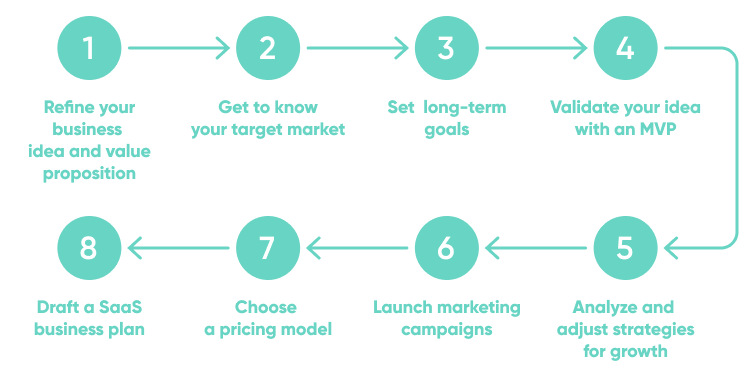
Refine your business idea and value proposition
A good product idea is always rooted in a real-life need. SaaS applications are no different. Your product should be filling a need in the market or solving a problem that real people or businesses are facing. You need to get really clear on the value you will provide to users with your application. The more clarity you can get, the better. Be careful that you don't stubbornly hang on to an initial idea you had for your business. As you get more information, be flexible to evolve your idea. The most successful businesses react to real market information, not gut feelings.
If you're unsure if your business idea and value proposition are well defined, ask yourself the following questions:
- Can I explain the product in less than 10 seconds?
- Does the value proposition stand out amongst the competition?
- Does the business idea resonate with customers in my target market?
- Can you back up your business idea with real data?
- If someone else had your business idea, would you be compelled to invest in it?
Often refining your business idea and value proposition goes hand in hand with understanding your target market. So, consider completing steps 2 and 3 in parallel. As you learn more about your target market, return back to refining your idea and value proposition.
Taking the time to refine your idea and value proposition is an essential first step to creating a successful SaaS company.
Get to know your target market
After you've refined your business idea it's time to spend time understanding your target market. As a SaaS company, the more you understand who your target market is, the better off you'll be at refining your business plan. You should gather as much information as possible about your target market including what they care about, what their values are, and what their challenges are. Here are a few ways to get to know your target market:
- Talk to potential customers. This can be done through surveys, interviews, or focus groups. Speaking directly with members of your target market is one of the best ways to get to know them. It is also typically expensive to conduct this type of research, but the cost may be worth it to better understand who you are trying to reach with your SaaS company.
- Look at your competition. See who their target market is and what they're doing to reach them. This can be an easy first step towards understanding your target market, but you should be careful not to assume your competition is trying to reach the exact same market as you or even if they have conducted thorough data-backed research.
- Analyze your own data. If you have existing customers, look at who they are and what they're using your product for. Some SaaS companies already have a data set they can work with. Using that can be a cost-effective way to better understand your market.
- Use market research tools. Look at demographic data, industry reports, and other data sources to get a better understanding of your target market.
- Search online forums like Reddit and Quora. These sites can give you a direct look into the questions and topics of interest for your target market. Even without surveying people directly, you can get a sense for the kinds of things people are asking about.
- Talk to experts. Speak with industry experts, analysts, and consultants to get their insights on your target market. If you're not able to do direct interviews, this is a great way to gather some data. Often industry experts have a unique view into the challenges, values, and preferences of a particular group of people.
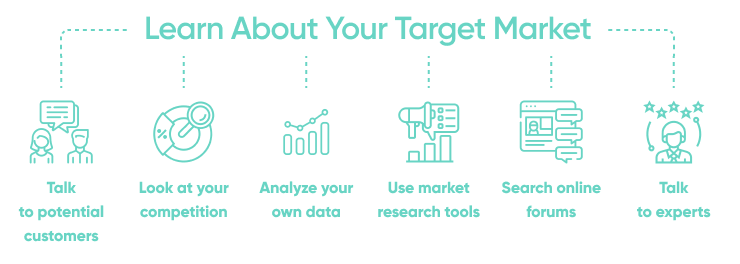
It can be helpful to divide and conquer when conducting market research as each type of information can take significant time to source, research, and document. Developing a solid plan for market research involves documenting what questions you want to answer. To help you get started, here is a set of questions that many SaaS businesses ask before building their product:
- What size companies are you targeting? Small, mid-size, or large?
- What stage companies are you targeting? Early startups, venture-based startups, or public companies?
- Are you targeting the public sector, government or non-profit organizations?
- What industries are you targeting? Be as specific as possible.
- What job titles do your target customers have?
- Are the decision makers and users of your SaaS product the same?
- What are the greatest concerns or challenges of your target customers?
- What are the biggest priorities of your target customers?
- What types of applications or SaaS software do your target customers already use?
- How comfortable are your target customers using technology?
- Do your target customers primarily use mobile or desktop applications?
- What do your target customers do in their free time?
Set long-term goals
Now that you have refined your SaaS business idea and have adequate data on your target market, you can start setting goals for your business. The important thing to note here is that we specifically want to create _long-term _goals for a new SaaS company.
Long-term goals help to set intentions for your business 5, 10, or even 20 years from now. They require having some perspective, zooming out to look at the big picture. It may be tempting to set short-term goals that feel more achievable. However, setting long-term goals early can set a tone for how you develop team culture, how you staff your team, how you market and relate to your customers, and what you invest your time and money in.
It's very difficult to change the early culture and focus areas of a business. The message your investors or first employees get from you as a founder early on will be hard to change. Without looking at the long-term roadmap you want your SaaS company to have, you risk being short-sighted and making choices that do not align with where you really want your business to go.
As you do this, it's important to keep a few key things in mind. First, you need to identify your target market and what needs your SaaS company will fill for them. Once you've done that, you can start to set more specific goals for your company.
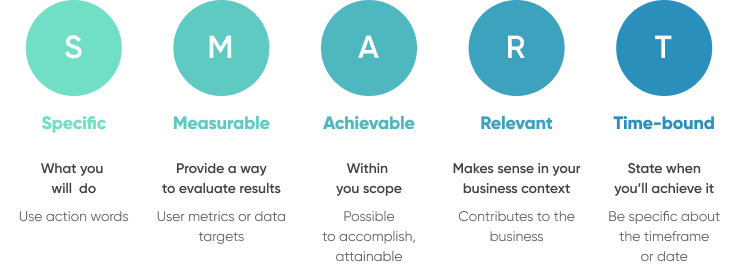
For example, if you want to become the leading SaaS provider in your software company, you'll need to set goals that reflect that ambition. That might mean setting a goal to achieve a certain revenue figure within a certain time frame, or to reach a certain number of customers.
Whatever goals you set, make sure they are specific, measurable, achievable, relevant, and time-bound (SMART). This will help you to stay on track and make sure you're making progress towards your long term vision for your SaaS company.
Choose a pricing model
When starting a SaaS company, you will need to choose a pricing model. The pricing model defines how your business will make money in exchange for providing software services to customers. It's important to thoroughly research (a) what customers expect in your target market and (b) what will work for your business. Balancing the two can be tricky.
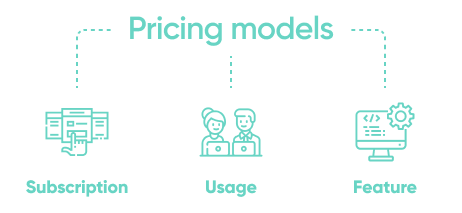
You can start to explore possible pricing models by looking at competitors and understanding the three most common pricing models for SaaS subscriptions: subscriptions, usage, and feature-based pricing.
Subscription
This is the most common pricing model for SaaS companies. With a subscription model, customers pay a recurring fee to access your software. Customers could pay monthly, quarterly, or annually. It's common for companies to offer a discount for longer subscription terms, which often incentives customers to commit to your product longer.
Usage
With a usage-based model, customers pay based on how much they use your software. It could be that you charge for a certain number of users or a certain amount of storage space that's used by your client. This model is common for companies that offer cloud-based services and often works in tandem with a standard subscription model.
Feature
With a feature-based model, customers pay for access to specific features of your software. This model is less common, but can be used for companies that offer unique features or a la carte pricing.
Keep in mind that many SaaS companies opt to offer a combination of these three pricing models to accommodate a variety of customers. You could also offer custom pricing models for individual clients. Once you have chosen a pricing strategy and set a price, you will need to regularly review it. Doing this will ensure that it is still in line with your costs and the value your software provides.
Draft a SaaS business plan
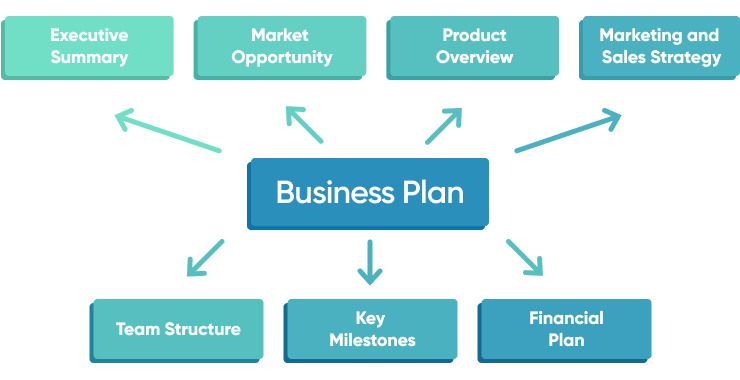
A business plan is essential for any tech startup seeking to raise investment. While there is no one-size-fits-all template for a tech startup business plan, there are certain elements that all successful plans should include:
- Company summary
- Market opportunity
- Product or service overview
- Marketing and sales strategy
- Team and management structure
- Key milestones
- Business model & financial plan
Painting a clear picture for potential investors of your SaaS business model and value proposition will help you to secure funding. It will also be helpful to have on hand for legal and tax purposes as you launch your business. As your business changes over time, make sure you revisit your business plan and update key sections.
Validate your idea with an MVP
An MVP, or minimum viable product, is a key tool for any startup. Building an MVP helps to validate your idea, receive real user feedback and improve your overall product design. Iteration is a concept that's embraced by many software development teams, and the use of an MVP is central to that. As you put out a version of your product into the world, you iterate and build the next version with the insight you gained from the MVP.
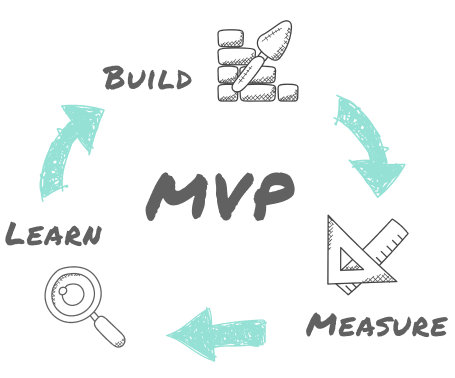
There are a few things to keep in mind when creating your MVP:
- Keep it simple. The whole point is to test your idea with a “bare minimum” version. Some may even choose to build an even simpler version of their product with a prototype before building out an MVP. Regardless, you don't want to delay getting a product into users' hands because you're trying to perfect it or add unnecessary features. Focus on simplicity for your MVP.
- Focus on your key value proposition. What is the one thing your product does that is most important to your users? You can always add on additional features later. As long as you are providing the main value proposition, you can consider your MVP a success.
- Get feedback early and often. Talk to your users and get their thoughts on your MVP. What do they like? What do they not like? What would they change? This input is invaluable to any SaaS company. As you get this information, make sure you come at it from an attitude of humility. You don't know everything. With a willingness to learn and adapt, your SaaS product has a greater chance of success.
- Be prepared to pivot. Your MVP is just a starting point. Be open to changing your product based on feedback from your users. The worst thing you can do is ignore user feedback. Leave room in your budget and schedule for reworking the next iteration of your SaaS application.
Startup MVP development is a great way to validate your startup idea. It allows you to test your hypothesis with real users, gather feedback, and iterate based on that feedback. Keep it simple, focus on your key value proposition, and be prepared to pivot based on user feedback.
Launch marketing campaigns
When you're ready to go to market, don't just throw up a website and call it a day. These days, you need to have strategic marketing campaigns to back your launch. Building out a marketing strategy may require the help of an expert. We won't cover everything you need to do to have a successful marketing launch, but we will touch on the basics to help you get started.

Before you start the SaaS development, make sure you've completed the previous steps, so you know your target market well and have a clearly defined value proposition. This will be critical in building a marketing plan that effectively reaches your target audience and resonates with them.
Once you know who you're going to reach, you need to work out how and with what. At the bare minimum, you should have a well designed website that is user-friendly and informative. Potential customers should be able to easily navigate your site and understand what your product does and more importantly, why they need it. To effectively convert website visitors, be sure to include strong calls-to-action on your website that lead to further marketing materials or free trials.
Now how will you get people to your website in the first place? This is where the real outbound marketing work comes in. Think about the channels (i.e. where) you can reach your target audience. Consider both paid and organic options:
Paid channels: Facebook Ads, Instagram Ads, YouTube Ads, LinkedIn Ads, Google Adwords, buying email lists, banner ads, influencer marketing, affiliate marketing
Organic channels: Building a following on social media, building an email list, manual outreach to friends and family, publishing press releases, content marketing
Try utilizing a variety of channels to see what works for your audience. At launch, many SaaS companies opt to use a combination of paid and organic channels to reach the most people. Over time, you may be able to reduce your paid media and focus on reaching your audience through earned/organic channels.
Get creative and think outside the box to make your campaigns stand out. With a little effort, you can successfully launch marketing and campaigns that will help your SaaS company take off.
Analyze and adjust strategies for growth
After launching your SaaS company, you should look at your launch data and prepare for the next phase: growth. Embracing a mindset of both iteration and growth will set your business up for success in the long term.
First, you should dive into how your go-to-market launch went. Look at all of the data you can get your hands on. Of course not everything will have gone perfectly. You may not have a final product, you may have some negative customer feedback, some marketing work may have been unsuccessful.
You may know off hand some of the things that you could improve. Other things may come out of the data. Regardless, you have an opportunity to learn from your work thus far and make some adjustments to your business model, SaaS products, and marketing strategies.
Consider asking the following questions at this stage:
- How has your SaaS product been received by the market?
- What specific feedback is continuing to come up from users?
- What marketing channels performed well? And which ones didn't perform well?
- What messages resonated with users?
- What feature requests are we getting most often?
As you begin to respond to early user feedback, you may find yourself redefining some of your business goals. As you do that, consider how your business can grow to achieve these new or modified goals.
- Do you need to hire additional staff?
- How can you best train existing staff?
- Do you need additional investors?
- What do you need to do to enable the most growth for your SaaS business?
- What business processes are working well? Which ones are slowing things down?
- What are the roadblocks to growth?
By following these key strategies and asking the right questions, you can set your SaaS business up for success and ensure that it can grow and scale over time.
Top tips for starting a successful SaaS business
In order to keep development lean and agile, it is important to start with a small, dedicated team. This team should be responsible for all aspects of the project, from development to operations. Focusing on automation, simplicity and quality will help to maximize development efforts of the SaaS application.
Working with a team who knows how to automate is key. Automate as much of the development process as possible. That includes things like continuous integration and automated testing. By automating these tasks, you can release new features faster and with fewer bugs.
The second step is to keep your codebase simple. That means avoiding unnecessary complexity and abstractions. The goal is to make your code easy to understand and easy to change. It's also important to have a project manager who can keep an eye on scope creep. Avoiding any unnecessary feature additions or changes will help to keep the development process running smoothly.
Finally, you need to focus on quality. That means writing clean, well-tested code. It also means making sure your application is stable and scalable.
By focusing on automation, simplicity, and quality you can keep software development lean and agile. Doing so will help you ship new features faster and build a better SaaS application.
Focus on delivering value to customers from day oneAs a new software application development team, it is essential that you focus on delivering value to customers from day one. This means understanding what customers need and want from your application and then building features and functionality that meets those needs. You must also be constantly aware of our application's performance and how it is being used by customers so that you can make improvements as needed.
Keeping customers in mind from the very beginning of your business will help you keep laser-focused on what really matters: delivering value to customers. Whenever you're in doubt, revisit how you can provide a higher customer experience.
Always be prepared to pivot and adapt as your business growsAs your business grows and changes, it's important to be prepared to pivot and adapt your strategies to stay ahead of the curve. As you get new information about your customers or industry, you should adjust your business plan and strategies. Here are a few tips to help you always be prepared to make changes in your business:
- Stay flexible: Don't get too attached to any one way of doing things. Be willing to try new things and change course if something isn't working. Holding on to ideas that no longer work is a sure fire way to set your business up for failure. The most successful companies remain flexible in all areas, so they can react quickly to changes in areas such as technology, customer preferences, and the competitive landscape.
- Be prepared to scale: As your business grows, you'll need to be prepared to scale up your operations. This means having the right infrastructure and staffing in place to support a larger business. Make sure you're ready and able to delegate work to trusted team members to prevent yourself from being the bottleneck to growth.
- Constantly monitor your industry: Keep tabs on your industry and be aware of changes that could impact your business. This will help you anticipate changes and adjust your plans accordingly.
- Be agile: Be prepared to rapidly adapt to changes. Having a team and business processes that allow for adaptability can help your team respond to change more quickly. Especially early in your business, you should prioritize agility.
- Be ready to pivot: Sometimes, the best course of action is to completely change direction. Be prepared to make radical changes if it means moving your business forward.
By following these tips, you'll be better prepared to handle whatever changes come your way. By being flexible and agile, you'll be able to adapt your business to meet customer expectations.
Wrap-up: how to start a SaaS company in 8 steps
Starting a new SaaS company certainly requires some grit. But grit alone won't equate to a successful business. To build a lasting business, you should have a detailed plan. In this article we walked you through 8 simple steps to get you on your way to starting your own SaaS company:
- Set long-term goals
- Refine your business idea and value proposition
- Get to know your target market
- Choose a pricing model
- Draft a SaaS business plan
- Validate your idea with an MVP
- Launch marketing and campaigns
- Analyze and adjust strategies for growth
As you follow these steps, remember to maintain a lean and agile development process, which will help to keep costs down and help you to ship features faster. Additionally, keeping customer experience top of mind will help to focus your team on what matters most. And, finally, developing a culture of adaptability will help you to pivot as expectations and requirements change (as they are bound to).
Starting a new SaaS company is an ambitious task, but with this guide, you'll be well on your way!


